A Statistical Approach for Analysis of Dissolution Rates Including Surface Morphology
Abstract
1. Introduction
2. Materials and Methods
2.1. Sample Description and Flow-Through Experiments
2.2. Surface Retreat Maps (∆h), Reaction Rate Maps (r) and Rate Spectra
2.3. Statistical Analysis
2.4. Grain Size Measurements
3. Results
3.1. Microstructure of the Reacted Calcite Patches
3.2. Height Maps and Reaction Rate Maps
3.3. Statistical Analysis of Rates
3.3.1. Intra-Pore Rate Variability (Total Material Flux, Central Tendencies, and Rate Maxima)
3.3.2. Inter-Pore Variability Statistics (Total Material Flux, Central Tendencies and Rate Maxima)
4. Discussion
4.1. From Polishing Defects to Crystallographically-Driven Dissolution
4.2. Intra-Variability of Rates
4.3. Inter-Pore Variability of Rates Versus Grain Size
4.4. Contribution of the Rate Maxima to the Overall Rates
4.5. Relevance to Previous Research and Implications
5. Conclusions
Supplementary Materials
Author Contributions
Funding
Acknowledgments
Conflicts of Interest
References
- Ruiz-Agudo, E.; Putnis, C.V.; Putnis, A. Coupled dissolution and precipitation at mineral–fluid interfaces. Chem. Geol. 2014, 383, 132–146. [Google Scholar] [CrossRef]
- Nermoen, A.; Korsnes, R.I.; Hiorth, A.; Madland, M.V. Porosity and permeability development in compacting chalks during flooding of nonequilibrium brines: Insights from long-term experiment. J. Geophys. Res. Solid Earth 2018, 123, 2090–2114. [Google Scholar] [CrossRef]
- Taylor, T.R.; Giles, M.R.; Hathon, L.A.; Diggs, T.N.; Braunsdorf, N.R.; Birbiglia, G.V.; Kittridge, M.G.; Macaulay, C.I.; Espejo, I.S. Sandstone diagenesis and reservoir quality prediction: Models, myths, and reality. Am. Assoc. Pet. Geol. 2010, 94, 1093–1132. [Google Scholar] [CrossRef]
- Wang, J.; Cao, Y.; Liu, K.; Liu, J.; Xue, X.; Xu, Q. Pore fluid evolution, distribution and water-rock interactions of carbonate cements in red-bed sandstone reservoirs in the Dongying Depression, China. Mar. Pet. Geol. 2016, 72, 279–294. [Google Scholar] [CrossRef]
- Hosa, A.; Wood, R. Quantifying the impact of early calcite cementation on the reservoir quality of carbonate rocks: A 3D process-based model. Adv. Water Resour. 2017, 104, 89–104. [Google Scholar] [CrossRef]
- Engelhardt, W.V. Die Bildung von Sedimenten und Sedimentgesteinen, 3rd ed.; Schweizerbart’sche, E.: Stuttgart, Germany, 1973; p. 378. [Google Scholar]
- Bjorlykke, K.; Ramm, M.; Saigal, G.C. Sandstone Diagenesis and Porosity Modification during Basin Evolution. Geol. Rundsch. 1989, 78, 243–268. [Google Scholar] [CrossRef]
- Yu, B.S.; Dong, H.L.; Ruan, Z. Mechanism for calcite dissolution and its contribution to development of reservoir porosity and permeability in the Kela 2 gas field, Tarim Basin, China. Sci. China Ser. D Earth Sci. 2008, 51, 567–578. [Google Scholar] [CrossRef]
- Kaszuba, J.; Yardley, B.; Andreani, M. Experimental perspectives of mineral dissolution and precipitation due to carbon dioxide-water-rock interactions. Rev. Mineral. Geochem. 2013, 77, 153–188. [Google Scholar] [CrossRef]
- McNamara, D.D.; Lister, A.; Prior, D.J. Calcite sealing in a fractured geothermal reservoir: Insights from combined EBSD and chemistry mapping. J. Volcanol. Geotherm. Res. 2016, 323, 38–52. [Google Scholar] [CrossRef]
- Rohmer, J.; Pluymakers, A.; Renard, F. Mechano-chemical interactions in sedimentary rocks in the context of CO2storage: Weak acid, weak effects? Earth-Sci. Rev. 2016, 157, 86–110. [Google Scholar] [CrossRef]
- Arvidson, R.S.; Ertan, I.E.; Amonette, J.E.; Luttge, A. Variation in calcite dissolution rates: A fundamental problem? Geochim. Cosmochim. Acta 2003, 67, 1623–1634. [Google Scholar] [CrossRef]
- Lasaga, A.C.; Blum, A.E. Surface chemistry, etch pits and mineral-water reactions. Geochim. Cosmochim. Acta 1986, 50, 2363–2379. [Google Scholar] [CrossRef]
- Jordan, G.; Rammensee, W. Dissolution rates of calcite (1014) obtained by scanning force microscopy: Microtopography-based dissolution kinetics on surfaces with anisotropic step velocities. Geochim. Cosmochim. Acta 1998, 62, 941–947. [Google Scholar] [CrossRef]
- Fischer, C.; Arvidson, R.S.; Luttge, A. How predictable are dissolution rates of crystalline material? Geochim. Cosmochim. Acta 2012, 98, 177–185. [Google Scholar] [CrossRef]
- Luttge, A.; Arvidson, R.S.; Fischer, C.; Kurganskaya, I. Kinetic concepts for quantitative prediction of fluid-solid interactions. Chem. Geol. 2019, 504, 216–235. [Google Scholar] [CrossRef]
- Luttge, A.; Arvidson, R.S.; Fischer, C. Fundamental Controls of Dissolution Rate Spectra: Comparisons of Model and Experimental Results. Procedia Earth Planet. Sci. 2013, 7, 537–540. [Google Scholar] [CrossRef]
- Bibi, I.; Arvidson, R.; Fischer, C.; Luttge, A. Temporal Evolution of Calcite Surface Dissolution Kinetics. Minerals 2018, 8, 256. [Google Scholar] [CrossRef]
- Noiriel, C.; Oursin, M.; Saldi, G.; Haberthür, D. Direct Determination of Dissolution Rates at Crystal Surfaces Using 3D X-ray Microtomography. ACS Earth Space Chem. 2019, 3, 100–108. [Google Scholar] [CrossRef]
- Brand, A.S.; Feng, P.; Bullard, W. Calcite Dissolution Rate Spectra Measured by In Situ Digital Holographic Microscopy Calcite Dissolution Rate Spectra Measured by In Situ Digital Holographic Microscopy. Geochim. Cosmochim. Acta 2017, 213, 317–329. [Google Scholar] [CrossRef]
- Fischer, C.; Gaupp, R.; Dimke, M.; Sill, O. A 3D high resolution model of bounding surfaces in aelian-fluvial deposits: An outcrop analogue study from the Permian Rotliegend, Northern Germany. J. Pet. Geol. 2007, 30, 257–273. [Google Scholar] [CrossRef]
- Fischer, C.; Dunkl, I.; Von Eynatten, H.; Wijbrans, J.R.; Gaupp, R. Products and timing of diagenetic processes in upper Rotliegend sandstones from Bebertal (North German Basin, Parchim formation, Flechtingen High, Germany). Geol. Mag. 2012, 149, 827–840. [Google Scholar] [CrossRef]
- Fischer, C.; Luttge, A. Beyond the conventional understanding of water–rock reactivity. Earth Planet. Sci. Lett. 2017, 457, 100–105. [Google Scholar] [CrossRef]
- Lea, A.S.; Amonette, J.E.; Baer, D.R.; Liang, Y.; Colton, N.G. Microscopic effects of carbonate, manganese, and strontium ions on calcite dissolution. Geochim. Cosmochim. Acta 2001, 65, 369–379. [Google Scholar] [CrossRef]
- Morse, J.W.; Arvidson, R.S. The dissolution kinetics of major sedimentray carbonate minerals. Earth-Sci. Rev. 2002, 58, 51–84. [Google Scholar] [CrossRef]
- Fischer, C.; Finkeldei, S.; Brandt, F.; Bosbach, D.; Luttge, A. Direct Measurement of Surface Dissolution Rates in Potential Nuclear Waste Forms: The Example of Pyrochlore. ACS Appl. Mater. Interfaces 2015, 7, 17857–17865. [Google Scholar] [CrossRef] [PubMed]
- Fischer, C.; Luttge, A. Pulsating dissolution of crystalline matter. Proc. Natl. Acad. Sci. USA 2018, 115, 897–902. [Google Scholar] [CrossRef]
- Luttge, A.; Bolton, E.W.; Lasaga, A.C. An interferometric study of the dissolution kinetics of anorthite: The role of reactive surface area. Am. J. Sci. 1999, 299, 652–678. [Google Scholar] [CrossRef]
- Lehmann, P.; Tereschenko, S.; Xie, W. Fundamental aspects of resolution and precision in vertical scanning white-light interferometry. Surf. Topogr. Metrol. Prop. 2016, 4, 024004. [Google Scholar] [CrossRef]
- Palandri, J.L.; Kharaka, Y.K. A Compilation of Rate Parameters of Water-Mineral Interaction Kinetics for Application to Geochemical Modeling; U.S. Geological Survey: Reston, VA, USA, 2004.
- de Assis, T.A.; Reis, F.D.A.A. Dissolution of minerals with rough surfaces. Geochim. Cosmochim. Acta 2018, 228, 27–41. [Google Scholar] [CrossRef]
- Kurganskaya, I.; Luttge, A. Kinetic Monte Carlo simulations of silicate dissolution: Model complexity and parametrization. J. Phys. Chem. C 2013, 117, 24894–24906. [Google Scholar] [CrossRef]
- Smith, M.E.; Knauss, K.G.; Higgins, S.R. Effects of crystal orientation on the dissolution of calcite by chemical and microscopic analysis. Chem. Geol. 2013, 360, 10–21. [Google Scholar] [CrossRef]
- Saldi, G.D.; Voltolini, M.; Knauss, K.G. Effects of surface orientation, fluid chemistry and mechanical polishing on the variability of dolomite dissolution rates. Geochim. Cosmochim. Acta 2017, 206, 94–111. [Google Scholar] [CrossRef]
- Bisschop, J.; Dysthe, D.K.; Putnis, C.V.; Jamtveit, B. In situ AFM study of the dissolution and recrystallization behaviour of polished and stressed calcite surfaces. Geochim. Cosmochim. Acta 2006, 70, 1728–1738. [Google Scholar] [CrossRef]
- Perez, A.; Daval, D.; Fournier, M.; Vital, M.; Delaye, J.M.; Gin, S. Comparing the reactivity of glasses with their crystalline equivalents: The case study of plagioclase feldspar. Geochim. Cosmochim. Acta 2019, 254, 122–141. [Google Scholar] [CrossRef]
- Hartman, P.; Perdok, W.G. On the relations between structure and morphology of crystals. I. Acta Cryst. 1955, 8, 49–52. [Google Scholar] [CrossRef]
- Kurganskaya, I.; Churakov, S.V. Carbonate Dissolution Mechanisms in the Presence of Electrolytes Revealed by Grand Canonical and Kinetic Monte Carlo Modeling. J. Phys. Chem. C 2018, 122, 29285–29297. [Google Scholar] [CrossRef]
- Hartman, P.; Perdok, W.G. On the relations between structure and morphology of crystals. II. Acta Cryst. 1955, 8, 521–524. [Google Scholar] [CrossRef]
- Hartman, P.; Perdok, W.G. On the relations between structure and morphology of crystals. III. Acta Cryst. 1955, 8, 525–529. [Google Scholar] [CrossRef]
- Zhang, L.; Luttge, A. Theoretical approach to evaluating plagioclase dissolution mechanisms. Geochim. Cosmochim. Acta 2009, 73, 2832–2849. [Google Scholar] [CrossRef]
- Briese, L.; Arvidson, R.S.; Luttge, A. The effect of crystal size variation on the rate of dissolution—A kinetic Monte Carlo study. Geochim. Cosmochim. Acta 2017, 212, 167–175. [Google Scholar] [CrossRef]
- Liu, J.; Aruguete, D.M.; Jinschek, J.R.; Donald, R.J.; Hochella, M.F. The non-oxidative dissolution of galena nanocrystals: Insights into mineral dissolution rates as a function of grain size, shape, and aggregation state. Geochim. Cosmochim. Acta 2008, 72, 5984–5996. [Google Scholar] [CrossRef]
- Kurganskaya, I.; Luttge, A. Kinetic Monte Carlo approach to study carbonate dissolution. J. Phys. Chem. C 2016, 120, 6482–6492. [Google Scholar] [CrossRef]
- Fischer, C.; Kurganskaya, I.; Schäfer, T.; Luttge, A. Variability of crystal surface reactivity: What do we know? Appl. Geochem. 2014, 43, 132–157. [Google Scholar] [CrossRef]
- Luttge, A. Etch pit coalescence, surface area, and overall mineral dissolution rates. Am. Mineral. 2005, 90, 1776–1783. [Google Scholar] [CrossRef]
- Godinho, J.R.A.; Piazolo, S.; Evans, L. Simulation of surface dynamics during dissolution as a function of the surface orientation: Implications for non-constant dissolution rates. Earth Planet. Sci. Lett. 2014, 408, 163–170. [Google Scholar] [CrossRef]
- Rohlfs, R.D.; Fischer, C.; Kurganskaya, I.; Luttge, A. Crystal dissolution kinetics studied by a combination of Monte Carlo and Voronoi methods. Minerals 2018, 8, 133. [Google Scholar] [CrossRef]
- Duckworth, O.W.; Martin, S.T. Dissolution rates and pit morphologies of rhombohedral carbonate minerals. Am. Mineral. 2004, 89, 554–563. [Google Scholar] [CrossRef]
- Davis, K.J.; Nealson, K.H.; Luttge, A. Calcite and dolomite dissolution rates in the context of microbe—Mineral surface interactions. Geobiology 2007, 5, 191–205. [Google Scholar] [CrossRef]
- Vinson, M.D.; Arvidson, R.S.; Luttge, A. Kinetic inhibition of calcite (104) dissolution by aqueous manganese (II). J. Cryst. Growth 2007, 307, 116–125. [Google Scholar] [CrossRef]
- Vinson, M.D.; Luttge, A. Multiple length-scale kinetics: An integrated study of calcite dissolution rates and strontium inhibition. Am. J. Sci. 2005, 305, 119–146. [Google Scholar] [CrossRef]
- Atanassova, R.; Cama, J.; Soler, J.M.; Offeddu, F.G.; Queralt, I.; Casanova, I. Calcite interaction with acidic sulphate solutions: A vertical scanning interferometry and energy-dispersive XRF study. Eur. J. Mineral. 2013, 25, 331–351. [Google Scholar] [CrossRef]
- Bouissonnié, A.; Daval, D.; Marinoni, M.; Ackerer, P. From mixed flow reactor to column experiments and modeling: Upscaling of calcite dissolution rate. Chem. Geol. 2018, 487, 63–75. [Google Scholar] [CrossRef]
- Colombani, J. The Alkaline Dissolution Rate of Calcite. J. Phys. Chem. Lett. 2016, 7, 2376–2380. [Google Scholar] [CrossRef] [PubMed]
- Heuer, J.; Luttge, A. Kinetics of pipeline steel corrosion studied by Raman spectroscopy-coupled vertical scanning interferometry. npj Mater. Degrad. 2018, 2, 40. [Google Scholar] [CrossRef]
- Holme, B.; Lunder, O. Characterisation of pitting corrosion by white light interferometry. Corros. Sci. 2007, 49, 391–401. [Google Scholar] [CrossRef]
- Dwivedi, D.; Lepková, K.; Becker, T. Carbon steel corrosion: A review of key surface properties and characterization methods. RSC Adv. 2017, 7, 4580–4610. [Google Scholar] [CrossRef]
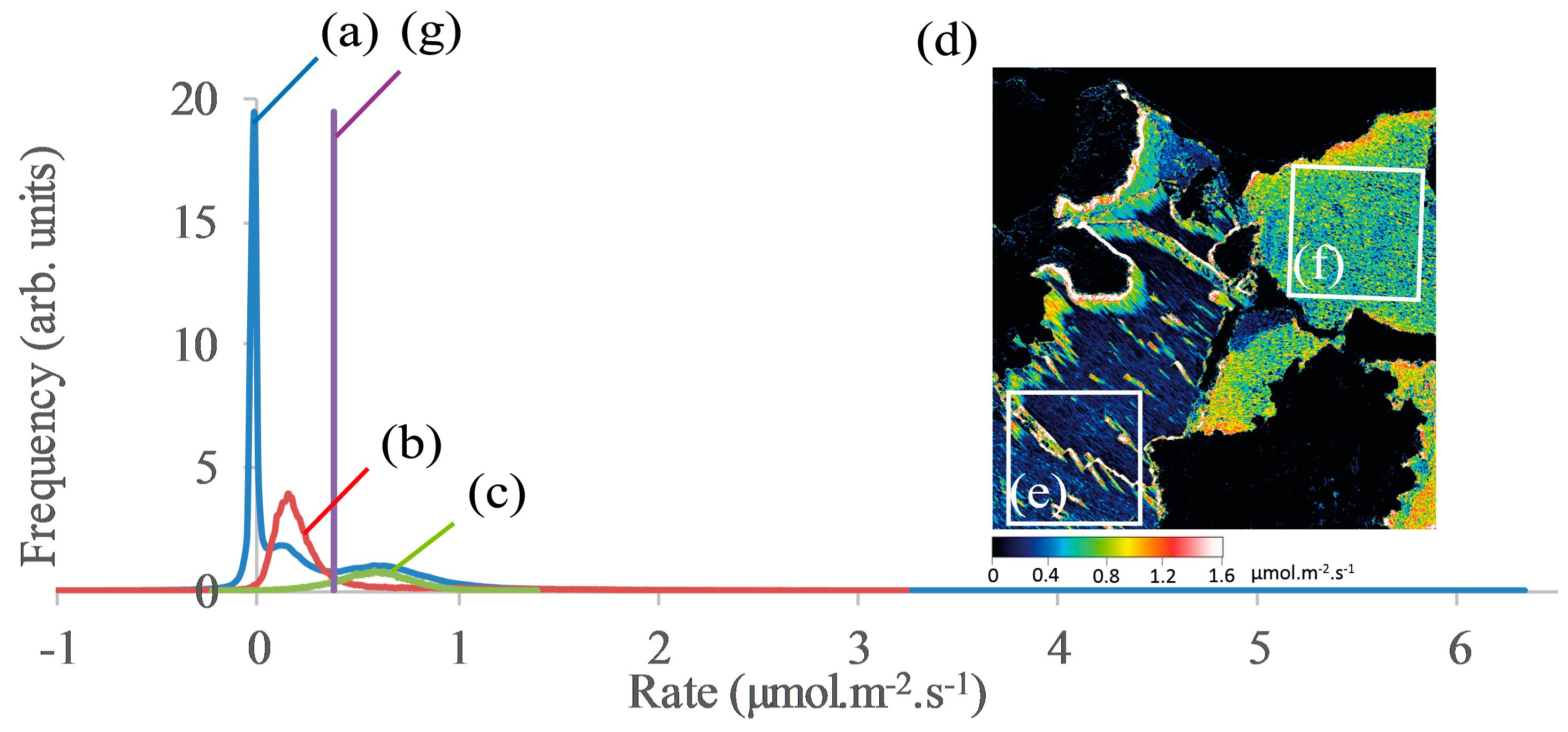
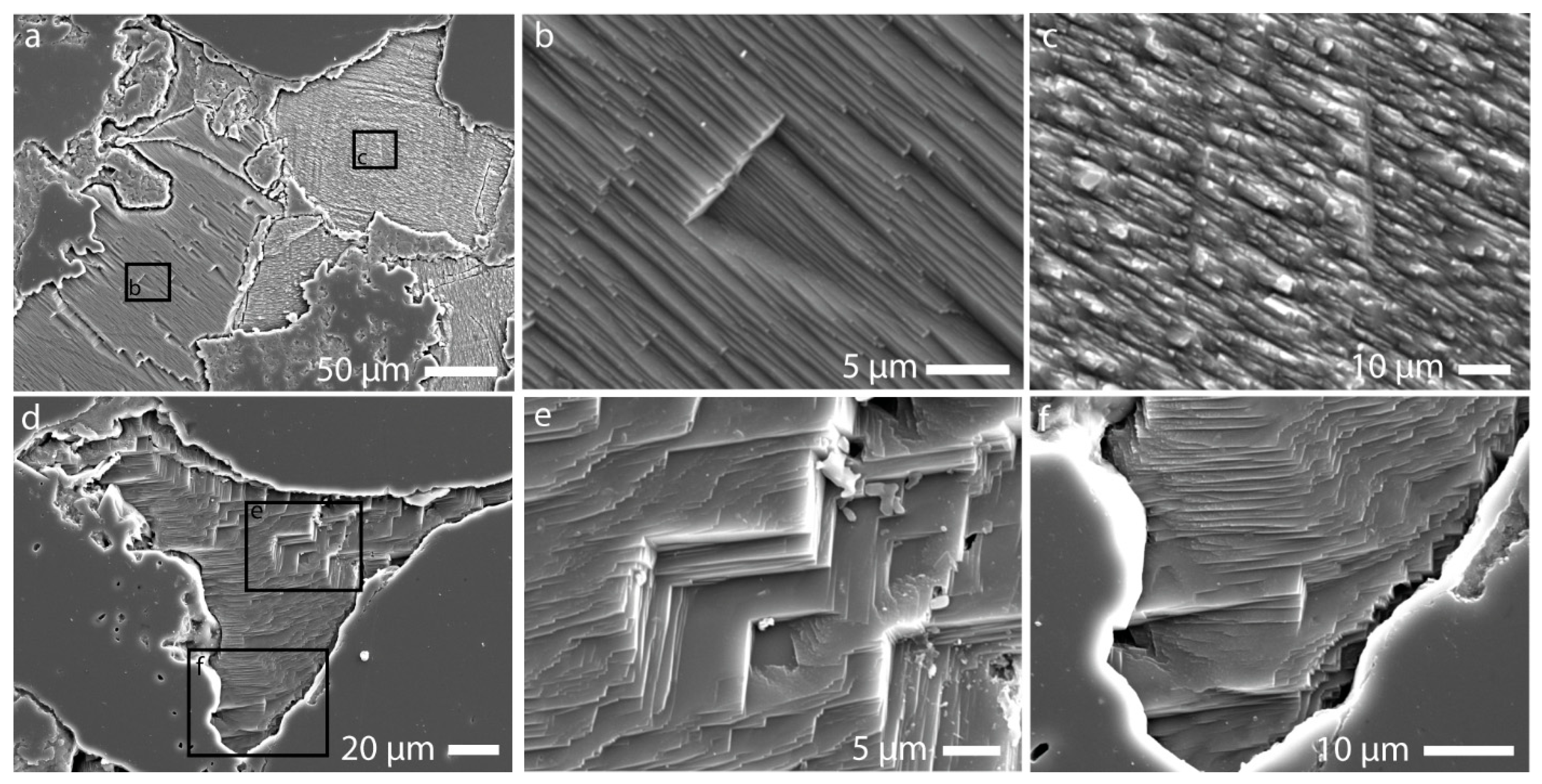
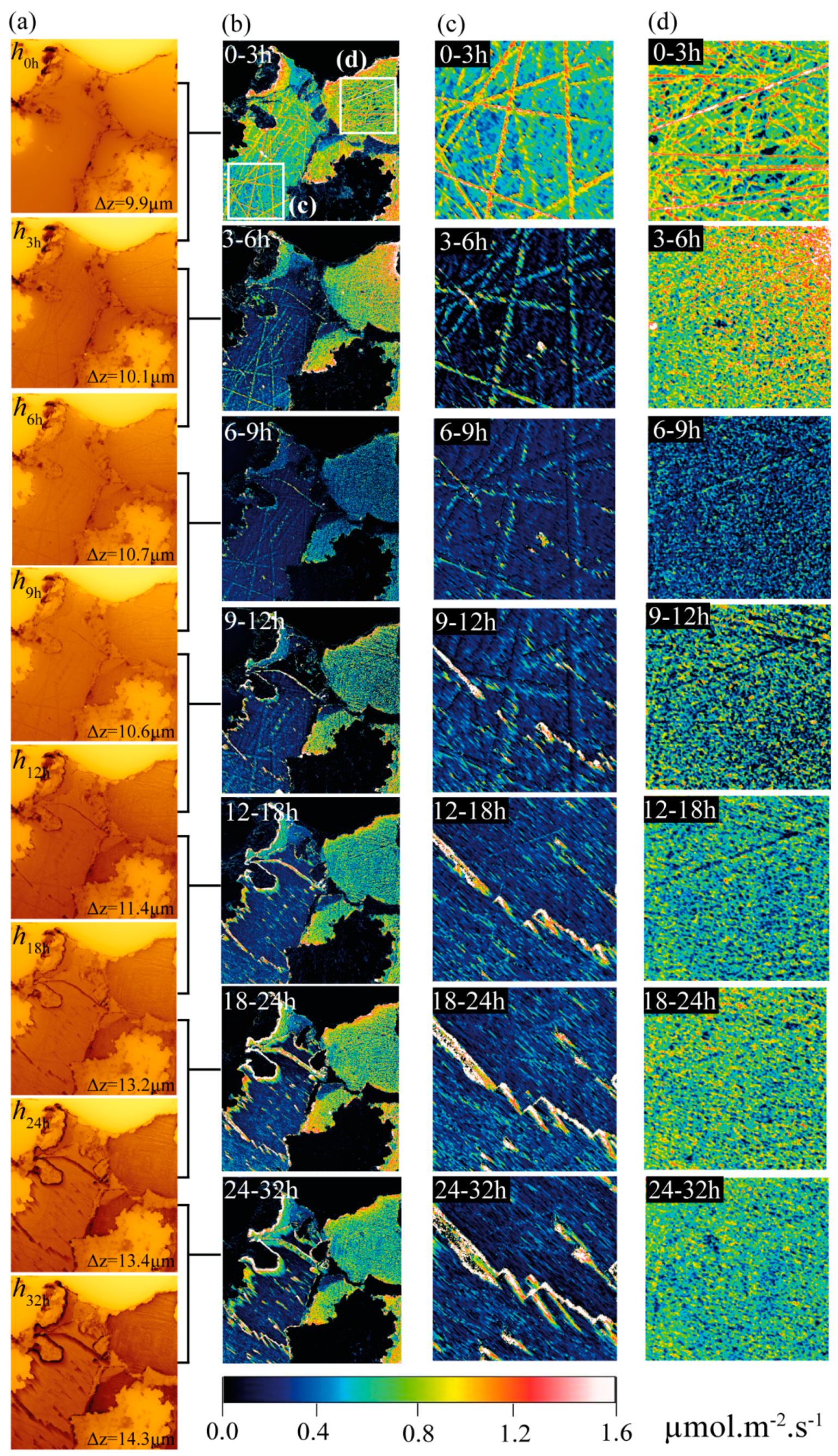
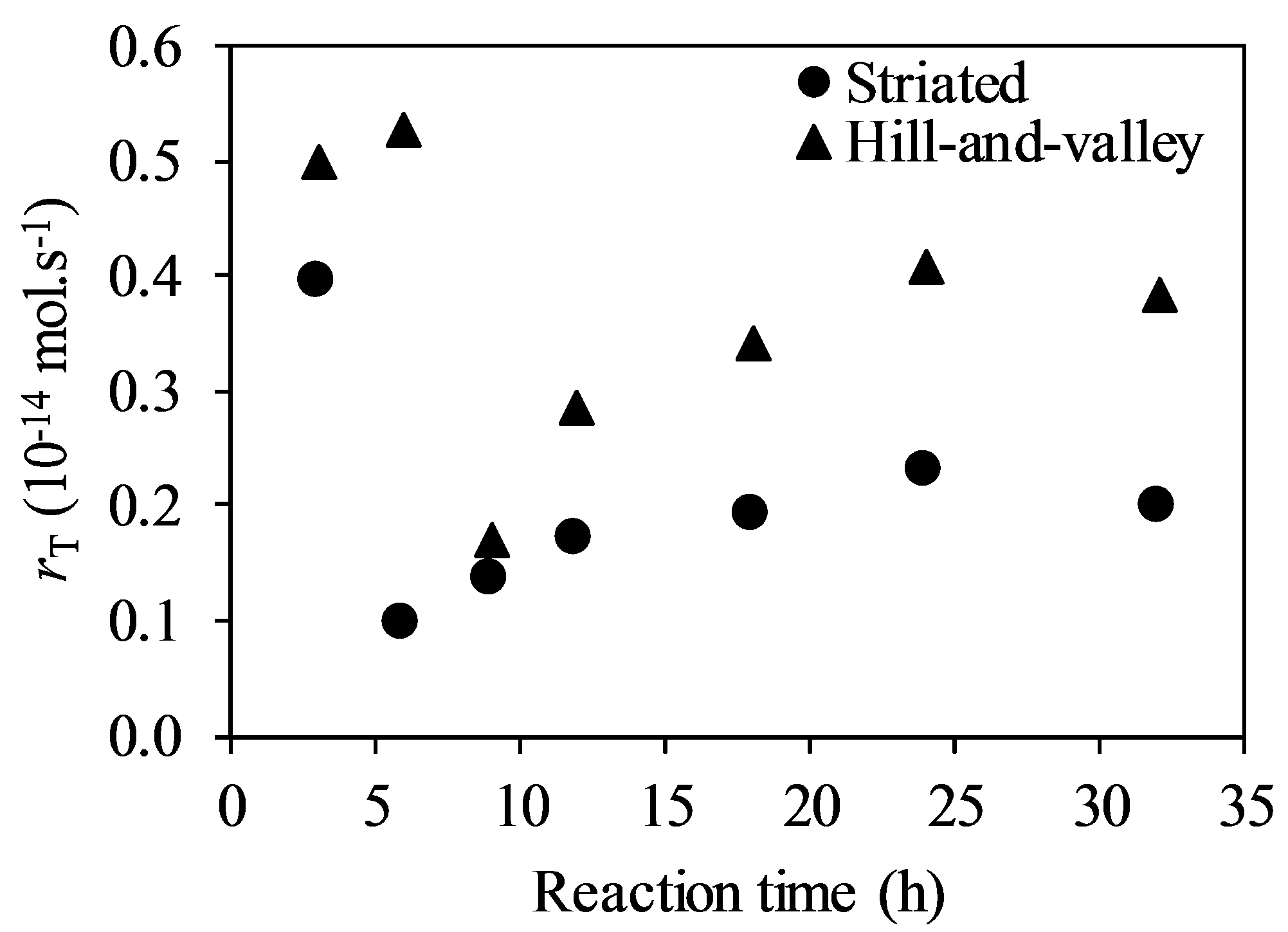
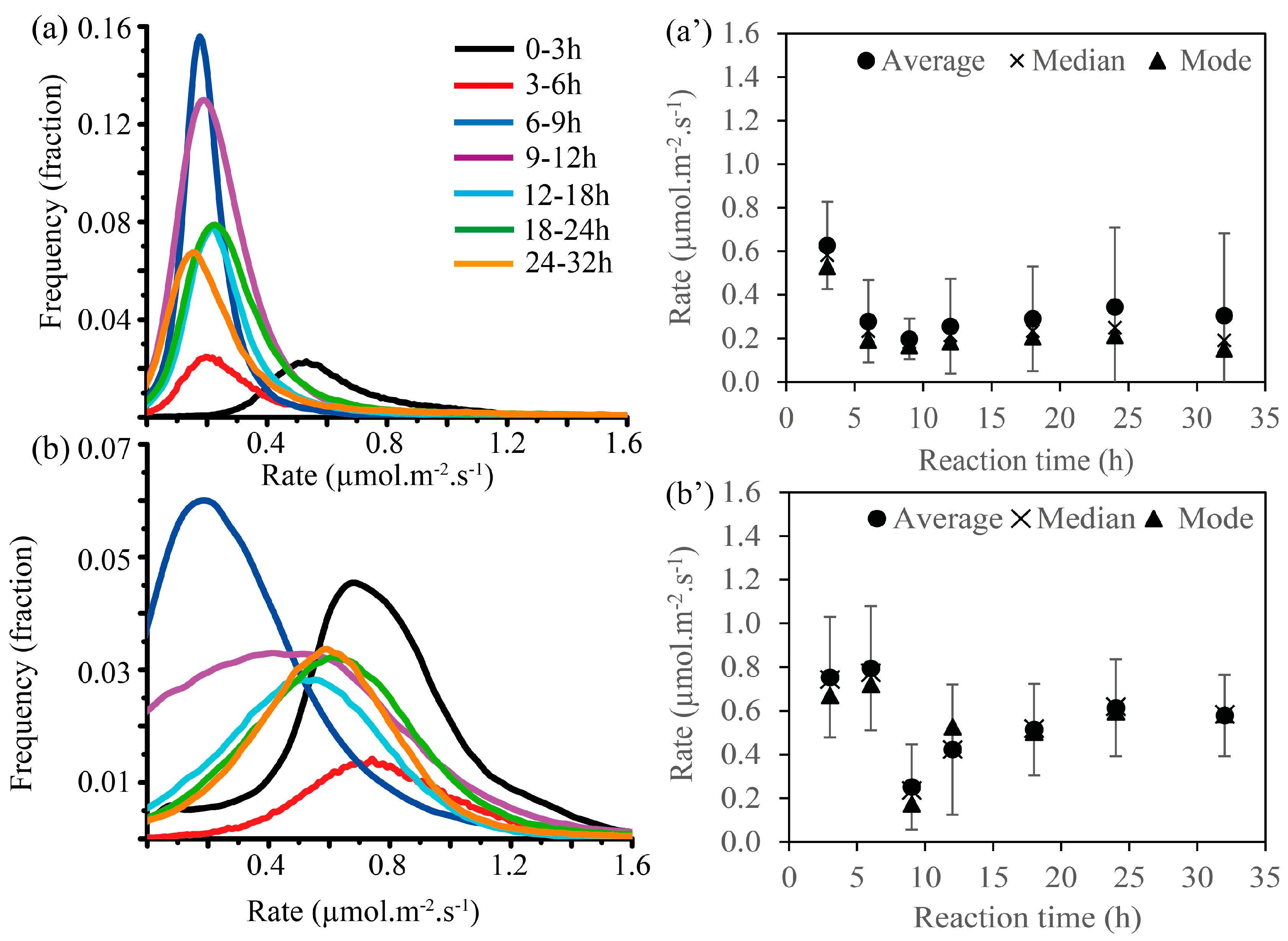
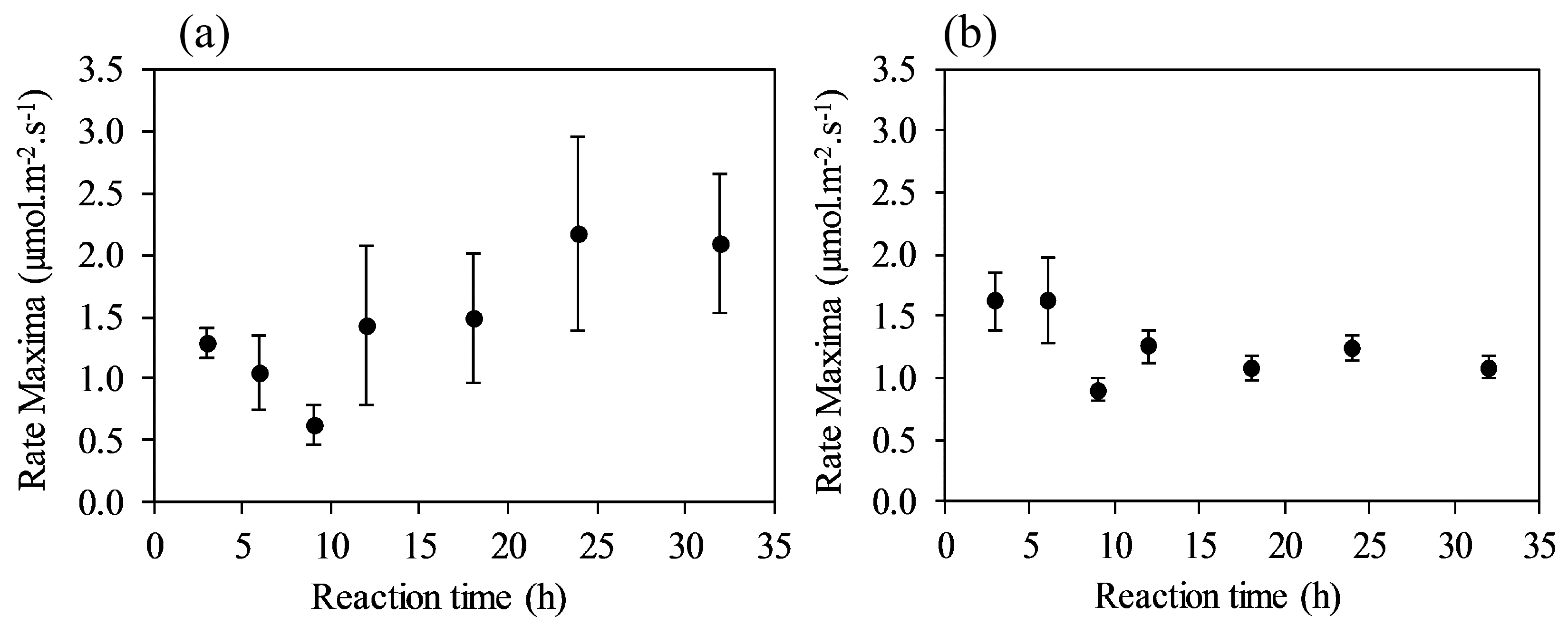


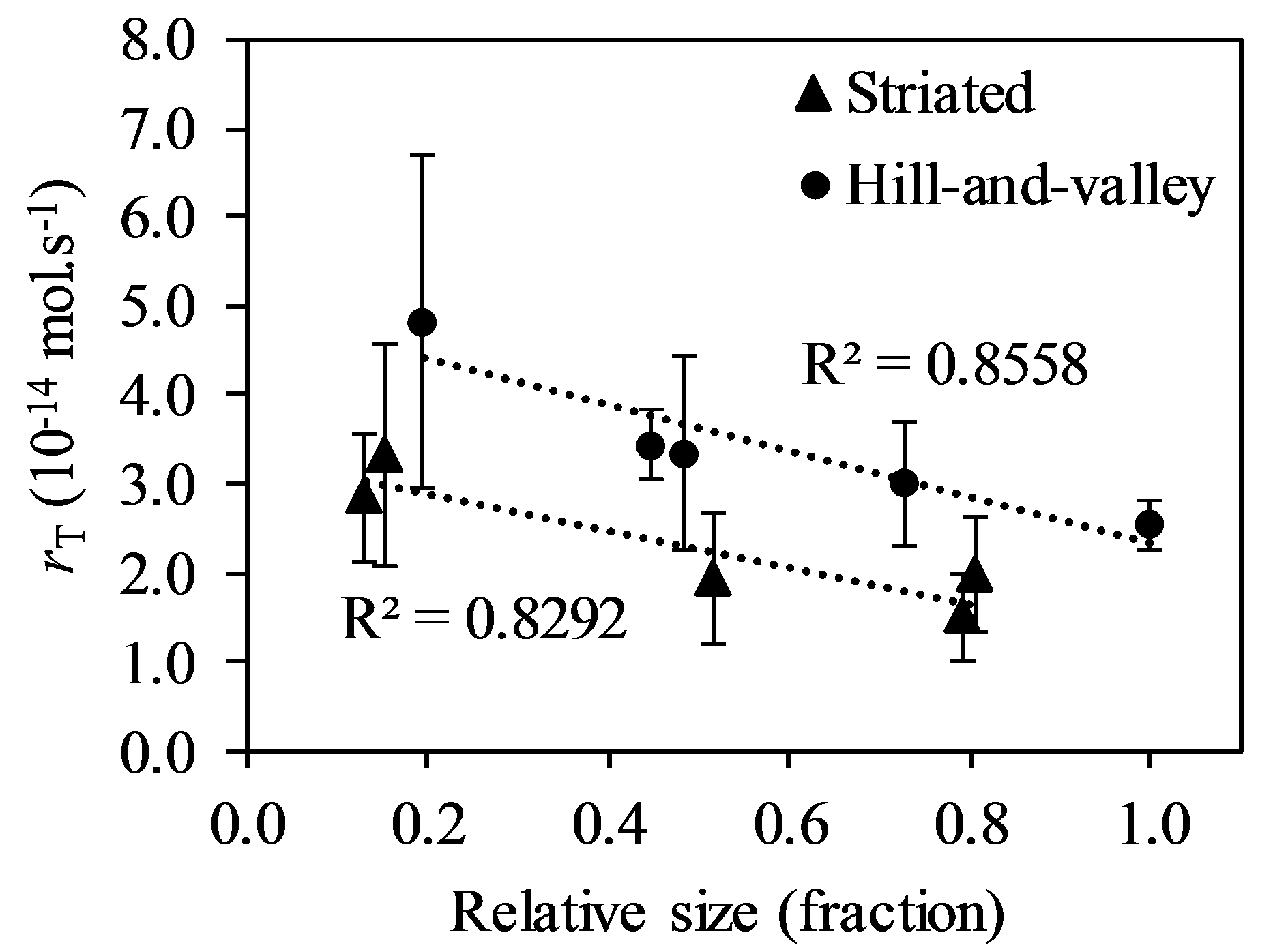
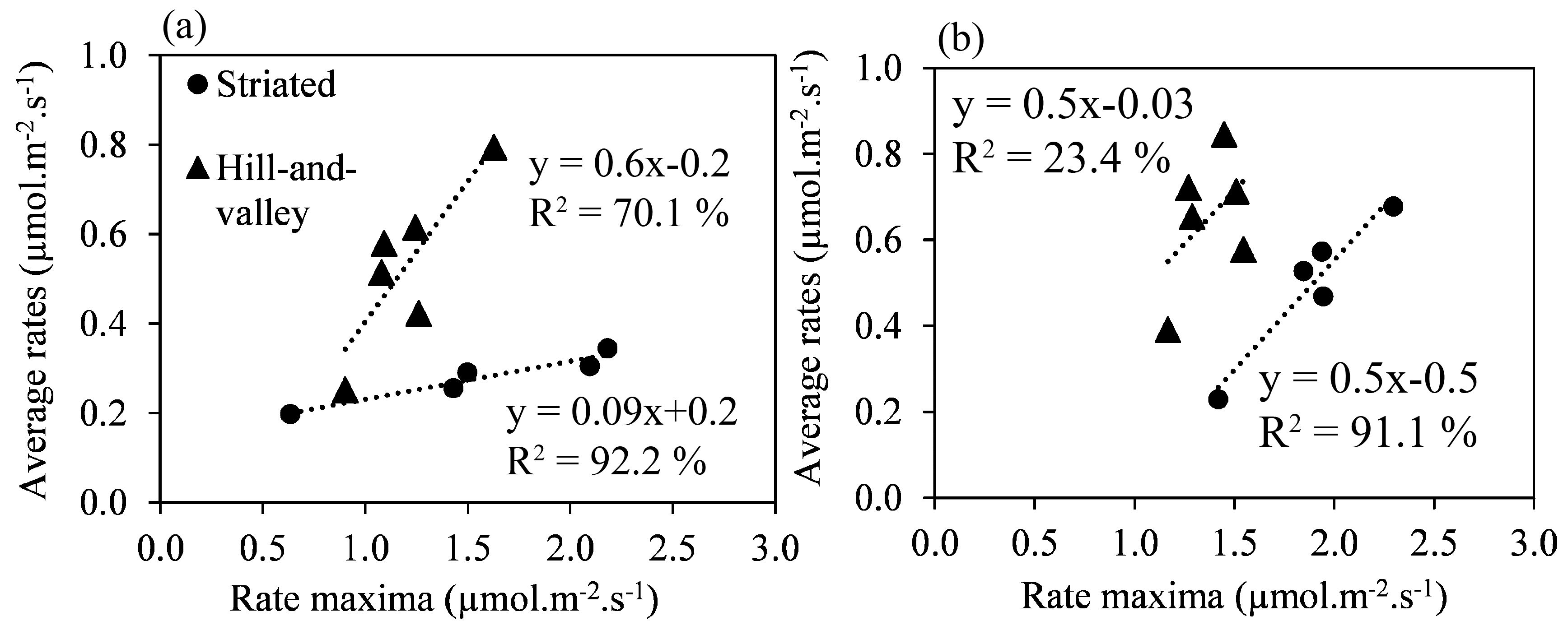
| Macroscopic | |
| Extrinsic | Intrinsic |
| Temperature | n° and distribution of defects (point and screw dislocations) |
| Pressure | Surface roughness |
| Fluid chemistry | Grain size and their distribution |
| Saturation state | Grain orientation |
| Ionic strength | Reactive surface features and their distribution |
| Material transport | |
| Micro-nanoscopic | |
| Extrinsic | Intrinsic |
| Ion hydration shells | Atomic step dynamics |
| Ionic transport mechanisms | Kink site distributions and densities |
| Ionic self-diffusion coefficients | Bond hydrolysis activation energies |
| Mechanisms of charge transfer | Coordination numbers |
| Adsorption/desorption of ions | Solid chemistry |
| Site protonation/deprotonation | Site acidity |
| Diffusion boundary layer structure | Surface-water interface molecular structure |
© 2019 by the authors. Licensee MDPI, Basel, Switzerland. This article is an open access article distributed under the terms and conditions of the Creative Commons Attribution (CC BY) license (http://creativecommons.org/licenses/by/4.0/).
Share and Cite
Trindade Pedrosa, E.; Kurganskaya, I.; Fischer, C.; Luttge, A. A Statistical Approach for Analysis of Dissolution Rates Including Surface Morphology. Minerals 2019, 9, 458. https://doi.org/10.3390/min9080458
Trindade Pedrosa E, Kurganskaya I, Fischer C, Luttge A. A Statistical Approach for Analysis of Dissolution Rates Including Surface Morphology. Minerals. 2019; 9(8):458. https://doi.org/10.3390/min9080458
Chicago/Turabian StyleTrindade Pedrosa, Elisabete, Inna Kurganskaya, Cornelius Fischer, and Andreas Luttge. 2019. "A Statistical Approach for Analysis of Dissolution Rates Including Surface Morphology" Minerals 9, no. 8: 458. https://doi.org/10.3390/min9080458
APA StyleTrindade Pedrosa, E., Kurganskaya, I., Fischer, C., & Luttge, A. (2019). A Statistical Approach for Analysis of Dissolution Rates Including Surface Morphology. Minerals, 9(8), 458. https://doi.org/10.3390/min9080458






